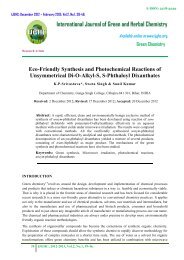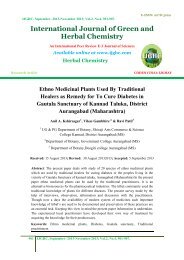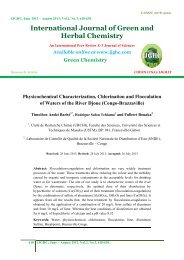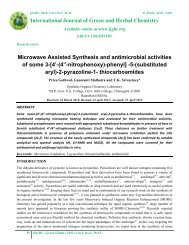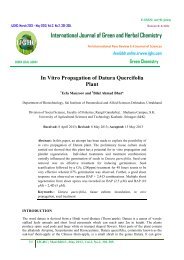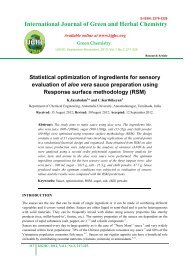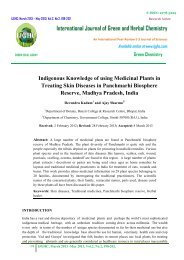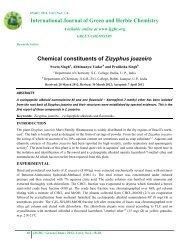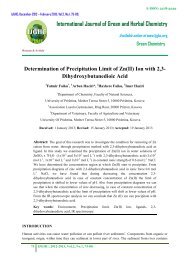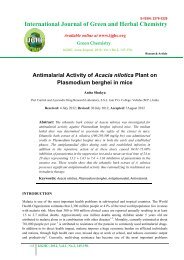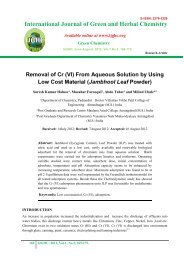journal Green corrected - IJGHC
journal Green corrected - IJGHC
journal Green corrected - IJGHC
You also want an ePaper? Increase the reach of your titles
YUMPU automatically turns print PDFs into web optimized ePapers that Google loves.
<strong>IJGHC</strong>; March 2013 – May 2013; Vol.2, No.2, 296-300.<br />
E-ISSN: 2278-3229<br />
Research Article<br />
International Journal of <strong>Green</strong> and Herbal Chemistry<br />
CODEN (USA): IJGHAY<br />
An International Peer Review E-3 Journal of Sciences<br />
Available online at www.ijghc.com<br />
<strong>Green</strong> Chemistry<br />
Determination of Pollution of River Zhegra through Algae<br />
Bioindicators during Winter Season<br />
Kemajl Kurteshi<br />
1<br />
Department of Bilogy, Faculty of Natyral Science, University of Prishtina, Kosova.<br />
Received: 16 April 2013; Revised: 3 May 2013; Accepted: 10 May 2013<br />
Abstract: The main objective of this study it was to investigate the algoflora and<br />
according the algae bioindicators to evaluate the level of pollution of water of river<br />
Zhegra, during the winter season in river Zhegra, nearby Gjilani City.The determined<br />
taxa of the Zhegra river are 81 species of algae, belonging to 4 divisions, were found.<br />
By their abundance, the algae from the divisions Bacillariophyta and Cyanophyta<br />
predominated in all locality of the longitudinal profile of the river and by their relative<br />
occurrence. Bacillariophyta 57 taxa (70.37%), Cyanophyta 11 taxa (13.58%),<br />
Euglenophyta 7 taxa(8.64%) and Chlorophyta 6 taxa (7.40%).<br />
Keywords: algae, winter, river, Zhegra, Gjilan, Kosovo<br />
INTRODUCTION<br />
Globally, degradation of environment due to the impacts of human activity is increasing.The ecology and<br />
distribution of algal vegetation in Kosovo, notably in Gjilani region rivers have been poorly<br />
investigated.Algae can be found in all aquatic habitats. In most streams and rivers, algae are the most<br />
diverse assemblage of organisms that can be sampled easily and identified readily to species or variety 1 .<br />
Algal species are excellent indicators of water quality and environmental change 2-5 .<br />
MATERIAL AND METHODS<br />
The samples were collected at 5 sampling stations along the river Zhegra in the winter of 2012. Water<br />
samples were collected in 500 ml glass bottles, 10 cm beneath the water surface, using standard methods<br />
6 . Conductivity, pH, salts, TDS (Total Disolved Salts), were measured in situ using mobile instruments<br />
(HACH), O 2 were measured with mobile instrument such as oxygenometer (Hana Instrument) and<br />
nutrients (N, P , Si ) were analysed by standard methods.<br />
296 <strong>IJGHC</strong>; March2013 -May 2013, Vol.2, No.2, 296-.
Determination ...<br />
Kemajl Kurteshi.<br />
Epilithon brushed from the stones with toothbrush and the upper layer of epipelon was pipetted off with a<br />
vacuum suction system 7. Epiphyton sampled with the substrate and palced in the plastic bottles .The algae<br />
examined using a Leica microscope, with a digital camera Fujifilm, which filmed the algae directly from<br />
the sample.<br />
DIATOMA CLEANING<br />
Cleaning of diatom frustules, preparation of permamnent slides and determinations follow Krammer &<br />
Lange-Bertalot 8 (1986-2001). Algal identification was done according to the keys:Cyanophyta: Elenkin 9<br />
1938, 1949; Starmach 10 1966.Bacillariophyta: Kramer, Lange-Bertalot 8 1986, 1988, 1991a, 1991b<br />
Xanthophyta: Fott(1983). Euglenophyta: Starmach 1983; Chlorophyta: Komárek and Fott 1983; Pascher<br />
1984, 1985.<br />
RESULTS AND DISCUSSION<br />
The results are presents in Table 1, were the division Bacillariophyta is represented through its highest<br />
number of species(57) and intraspecific taxonomic varieties, among which are Nitzschia with 11 species,<br />
Navicula 8, Surirella-4, while Gomphonema, Fragilaria and Diatoma are represent with 3 species. As<br />
we can observe from Table 1, the most numerous from the point of their taxonomic difference are<br />
genders Nitzschia the quantity of which is about 19.23 % from the total number of the discovered<br />
Bacillariophyta followed by Navicula -14.03%, Surirella – 7.01 %, all the rest are less varied but anyway<br />
create a different flora spectrum. From gender Nitzschia more frequently is discovered Nitzschia<br />
eleganula, N.dissipata, N. fonticola.The variety of species change radically depending on their place of<br />
collection, for example in the water of the effluents and old course of the river is discovered quite<br />
frequently different species of alfa and beta mezosaprobs.From the representatives of filumi<br />
Cyanophyta(11 taxa) most rich genus is Oscillatoria with 2 taxa, the representatives of which constitute<br />
about 18.18 % from the total number of Cyanophyta. The other gender are represent by one taxa.Division<br />
Chlorophyta is represented by 4 gender, with dominating gender Cladophora with 3 taxa.Algoflora of the<br />
river is characterized by a big variety of Euglenophyta withdominating genus: Euglena(3 taxa) or 42.86<br />
% of total euglenophyta.Trachelomonas with 2 species, Phacus with 2 species.Registered 32<br />
bioindicators species, where dominate the bioindicators species which belongs to betamesosaprobic level<br />
of saprobity (14 taxa), followed by oligosaprob bioindicators- 10 taxa, oligobetamesosaprob<br />
bioindicators (7 taxa), alfamesosaprob bioindicators- 1 species, while oligosaprob to xenosaprob<br />
registred 3 species and xenosaprob registred 1 species. According the bioindicators the waters of river<br />
Zhegra belongs oligosaprob to betmesosaprob class of bonity 11-17 .<br />
Table- 1: Determined algae in the river Zhegra during winter season 2012<br />
LOCALITIES<br />
Division CYANOPHYTA<br />
Level of<br />
Saprobity<br />
297 <strong>IJGHC</strong>; March2013 -May 2013, Vol.2, No.2, 296-300.<br />
1 2 3 4 5<br />
81 Total number of algae<br />
Division CYANOPHYTA<br />
1 Anabaena plantonica Brunnth. 1 1 1<br />
2 Chroococcus varius Al.Br. 1 1<br />
3 Dactylococcopsis acicularis Lemm 1 1 1<br />
4 Gloetrichia echinulata (G.S.Smith).P.Richt. β 1 1
Determination ...<br />
Kemajl Kurteshi.<br />
5 Microcystis grevillei f.grevillei (Hass)Elenk. 1 1<br />
6 Merismopedia tenuissima β 1<br />
7 Nodularia spomigena Mert. 1 1<br />
8 Oscillatoria mirabilis Böcher 1 1 3 3 1<br />
9 O.nitida Schkord 1 1<br />
10 Phormidium ambiguum Gom. β 1 3 1<br />
11 Spirulina platensis (Nordst)Geitler. β 1 1<br />
Division BACILLARIOPHYTA<br />
1 Achnanthes hungarica (Grunow) Grunow o 1 1<br />
2 Achnanthidium minutissimum(Kütz.)Czarneck 1 1 1<br />
3 Amphora lybica Ehrenberg 1 1 1<br />
4 A. normani Rabenhorst o 1 3 3<br />
5 Aneumastus stroesei (Ostrup) Mann 1<br />
6 Cocconeis pediculus Ehrenberg ο- β 1 3 1<br />
7 C. placentula var. lineata (Ehrenberg) Cleve 3 1 5 3<br />
8 Cyclotella ocellata Pantocsek 1 1<br />
9 Cymatopleura solea (Brébisson) W.Smith β 1 1<br />
10 Cymbella affinis Kützing ο- β 3 3 3 1<br />
11 C. helvetica Kützing o 3 1 3 3 1<br />
12 Diatoma ehrenbergii Kützing 3 1 5 3<br />
13 D. moniliforme Kützing 3 1<br />
14 D. vulgaris Bory β 1 3 3<br />
15 Epithemia adnata (Kützing) Brébisson 3 1<br />
16 Fragilaria capucina Desmazières ο- β 3 1<br />
17 F. ulna (Nitzsch) Lange-Bertalot 1 1<br />
18 F. ulna complex oxyrhynchus Lange-Bertalot 1 1<br />
19 Gomphonema carolinense Hagelstein 1 1<br />
20 G. olivaceum (Hornemann) Brébisson β 1 1 1<br />
21 G. parvulum (Kützing) Kützing β 1 1 1<br />
22 Gyrosigma acuminatum (Kützing) Rabenhorst β 1 1<br />
23 G. attenuatum (Kützing) Rabenhorst β 1 1 1<br />
24 Luticola goeppertiana (Bleish) Mann 1 1 1<br />
25 Melosira varians Agardh β 1 1 1<br />
26 Meridion circulare (Grev.) C. Ag. o 1 1 1<br />
27 Navicula capitatoradiata Germain 1 1 1<br />
28 N. cryptotenella Lange-Bertalot 3 3<br />
29 N. species aff radisafallax Lange-Bertalot 1 1<br />
30 N. tripunctata (O.F.Müller) Bory 3 3 1<br />
31 N. trivialis Lange-Bertalot 3 3<br />
32 N. tuscula Ehr. o- β 1 1 1<br />
33 N. viridula (Kützing) Ehrenberg α 1 5 3<br />
34 N. viridula var.rostellata(Kützing) Cleve 3 3<br />
35 Nitzschia acula Hantzsch in Rabenhorst 1 1<br />
36 N. acicularis (Kütz.) W. Sm. 1 1<br />
37 N. capitellata Hustedt 3 3<br />
38 N. closterium( Ehrenberg)W.Smit 3 1 1<br />
39 N. constricta(Kützing)Ralfs 1 3<br />
40 N. commutata Grun. 1 1<br />
41 N. dissipata (Kützing) Grunow ο- β 1 1 3 3<br />
42 N. elegantula Grunow in Van Heurck 1 1 3 1<br />
43 N. eglei Lange Bertalot 1 1<br />
44 N. litoralis Gruow 1 1<br />
45 N. linearis (Agardh) W.Smith ο- β 1 1<br />
298 <strong>IJGHC</strong>; March2013 -May 2013, Vol.2, No.2, 296-300.
Determination ...<br />
Kemajl Kurteshi.<br />
46 Pinnularia microstauron (Ehrenberg) Cleve o-x 3 1 1<br />
47 P.microstauron var. brebisonii(Kützing)Mayer x 3 1<br />
48 Rhoicosphaenia abbreviata (Ag.)Lange- x-o 1 1 1<br />
Bertalot<br />
49 Stauroneis smithii Grunow x-o 1<br />
50 S.anceps Ehrb. 1 1<br />
51 Surirella angusta Kützing o 1 1<br />
52 S.ovalis Breb. o 1 1 1<br />
53 S.patella Kützing 1 1<br />
54 S.robusta Ehrenberg 1 1<br />
55 Synedra acus Hustedt 1 1 1 1<br />
56 S.nana Meister 1<br />
57 S.ulna Kützing 1 1 1<br />
Division EUGLENOPHYTA<br />
1 Euglena acus Ehrenb. β 1<br />
2 E.minima Fr. o 1 1 1<br />
3 E.oblonga Lemm. 1 1 1<br />
4 Phacus orbicularis Hübn. β 1 1<br />
5 Ph.pusillus Lemm. 1 1<br />
6 Trachelomonas affinis Lemm. 1 1 1<br />
7 T. bituricensis Ehrenberg 1 1<br />
Division CHLOROPHYTA<br />
1 Cladophora glomerata Kützing β 1 1<br />
2 C.praelongum Bréb. 1 1 1<br />
3 C.pronum Bréb. 1 1<br />
4 Desmodesmus perforatus (Lemm.) Hegew. 1 1 1<br />
5 Microspora flocosa (Vauch)Thuret. 1 1<br />
6 M.elegans Hansg. 1 1<br />
CONCLUSIONS:<br />
During summer season determined 81 species.<br />
In river Drino, dominate diatoma with 57 species.<br />
Determined 32 bioindicators species.<br />
Dominated the beta mesosaprobic bioindicators (14 bioindicators species)<br />
According to the bioindicators species and physico-chemical parameters, investigate waters<br />
classified in II class of bonity respectively at beta mesosaprob level.<br />
REFERENCE<br />
1. R.J.Stevenson, J.P.Smol, Use of algae in environmental assessments, in J.D.Wehr, and R.G.Sheath, eds.,<br />
Freshwater algae of North America—Ecology and classification: San Diego, Calif., Academic Press, 2003,<br />
775–804.<br />
2. S..S.Dixit,J.P. Smol, Long-term trends in lake water pH and metal concentrations inferred from diatoms<br />
and chrysophytes in three lakes near Sudbury, Ontario: Canadian Journal of Fisheries and Aquatic<br />
Sciences,1992, 49, 17–24.<br />
3. S.S.Dixit,J.P.Smol, J.C. Kingston,D.F. Charles, Diatoms—Powerful indicators of environmental change:<br />
Environmental Science and Technology,1992, 26, 22–33.<br />
4. J.M.Hellawell, Biological indicators of fresh-water pollution and environmental management. Elsevier<br />
Appl. Sci. Publ., London,1986,.<br />
299 <strong>IJGHC</strong>; March2013 -May 2013, Vol.2, No.2, 296-300.
Determination ...<br />
Kemajl Kurteshi.<br />
5. W.L.Hilsenhoff, Rapid field assessment of organic pollution with a family-level biotic index. J. N. Am.<br />
Benthol. Soc.1988, 7(1):65-68<br />
6. H.B.N.Hynes, The use of biology in the study of water pollution. 1964, Chem. Ind., J.L.Wilhm ,<br />
Biological indicators of pollution, pp. 375-403. In: Whitton, B. A. (ed.),1975.<br />
7. River ecology, Studies in ecology, Vol. 2, Blackwell Sci. Publ. E le n k i n AA, (1938): Monographia<br />
algarum Cyanophyearum aquidulcium et terestrium in finibus URSS inventarum. Fasc. I. Akademija nauka<br />
SSSR. Moskva 984 str.<br />
8. A.Lungu, P. Obuh, Diversitatea si rolul algelor în purificarea apei reziduale de la fabrica de zahsr Drochia,<br />
Aa. USM., stiinse ale naturii, Ser. Lucr. stud., Chisinsu, (b):2001, 74-77.<br />
9. A.A.E le n k i n, Monographia algarum Cyanophyearum aquidulcium et terestrium in finibus URSS<br />
inventarum. Fasc. II. Akademija nauka SSSR.Moskva 984 str.1949.<br />
10. K.Starmach Chlorophyta III. Zielenice nitkowate. In: Flora Sladkowodna Polski (Starmach, K., Ed.) Tom<br />
10. Pañstwowe Wydanictwo Naukowe,Warszawa – Kraków. 1972a.<br />
11. H.E t t l,: Chlorophyta I. Phytomonadina. Band 9. U: Süßwasserflora von Mitteleuropa (Ettl, H., Gerloff,<br />
J., Heynig, H., Mollenhauer, D., Eds.) Gustav,1983.<br />
12. M.Meybeck,R. Helmer, The quality of rivers: from pristine stage to global pollution. Palaeogeography,<br />
Palaeoclimatology, Palaeoecology (Global and Planetary Change Section),1989, 75: 283 – 309.<br />
13. R.J.Stevenson, Effects of current and conditions simulating autogenically changing microhabitats on<br />
benthic diatom immigration: Ecology,1983,. 64, 6, 1514–1524<br />
14. E.F.Stoermer, J.P.Smol, The diatoms— Applications for the environmental and earth sciences: Cambridge,<br />
U.K., Cambridge University Press,1999,.<br />
15. D.Tilman, Resource competition between planktonic algae—An experimental and theoretical approach:<br />
Ecology,1977, 58, 338–348.<br />
16. H.Van Dam,A. Mertens J. Sinkeldam J, (1994), A coded checklist and ecological indicator values of<br />
freshwater diatoms from the Netherlands: Netherlands Journal of Aquatic Ecology,1994, 28, 1, 117–133.<br />
17. J.D.Wehr,R.G. Sheath, Freshwater algae of North America—Ecology and classification: San Diego, Calif.,<br />
Academic Press, 2003.918 .<br />
*Corresponding Author; Kemajl Kurteshi; Department of Bilogy, Faculty of Natyral Science, University of Prishtina<br />
,Kosova<br />
300 <strong>IJGHC</strong>; March2013 -May 2013, Vol.2, No.2, 296-300.



